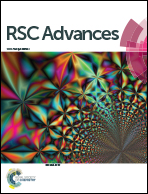Synthesis and biological evaluation of 4-(1H-1,2,4-triazol-1-yl)benzoic acid hybrids as anticancer agents†
Abstract
A series of 4-(1H-1,2,4-triazol-1-yl)benzoic acid hybrids (1–17) was successfully synthesized and their structures were established by NMR and MS analysis. In vitro cytotoxic evaluation indicated that some of the hybrids exhibited potent inhibitory activities against MCF-7 and HCT-116 cancer cell lines, with IC50 values ranging from 15.6 to 23.9 µM, compared with reference drug doxorubicin (19.7 and 22.6 µM, respectively). Notably, the most potent compounds, 2, 5, 14, and 15, not only exhibited an obvious improvement in IC50 values, but demonstrated very weak cytotoxic effects toward normal cells (RPE-1) compared with doxorubicin. A further investigation showed that compounds 2 and 14 clearly inhibited the proliferation of MCF-7 cancer cells by inducing apoptosis. In addition, these hybrids showed acceptable correlation with bioassay results in regression plots generated by 2D QSAR models. Our results indicated that 1,2,4-triazole benzoic acid hybrids could be used as a structural optimization platform for the design and development of more selective and potent anticancer molecules.



 Please wait while we load your content...
Please wait while we load your content...